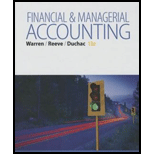
(1)
Accounts receivable turnover is a liquidity measure of accounts receivable in times, which is calculated by dividing the net credit sales by the average amount of net accounts receivables. In simple, it indicates the number of times the average amount of net accounts receivables has been collected during a particular period.
Average collection period:
Average collection period indicates the number of days taken by a business to collect its outstanding amount of accounts receivable on an average.
To calculate: The accounts receivable turnover for Year 2 and Year 1.
(2)
To calculate: The day’s sales in receivables at the end of Year 2 and Year 1.
(3)
To conclude: The Efficiency of Company B’s management in collecting accounts receivables.
(4)
The assumption about sales that might distort the ratios and makes the ratios not to be comparable for Year 2 and Year 1.
Want to see the full answer?
Check out a sample textbook solution
Chapter 8 Solutions
Bundle: Financial & Managerial Accounting, 13th + CengageNOWv2, 2 terms (12 months) Printed Access Card
- What is the amount of current assetsarrow_forwardSubject: Accountingarrow_forwardLeague of Legends Systems plans to produce 30,000 units next period at a denominator activity of 60,000 direct labor hours. The direct labor wage rate is $15.00 per hour. The company’s standards allow 3 yards of direct materials per unit, and materials cost $8.50 per yard. The company’s budget includes variable manufacturing overhead of $2.80 per direct labor hour and fixed manufacturing overhead. Using 60,000 direct labor hours as the denominator activity, compute the predetermined overhead rate and break it down into variable and fixed elements.arrow_forward
- Saran Enterprises sells a product for $45 per unit and has a contribution margin ratio of 60%. Fixed expenses total $180,000 annually. How many units must be sold to yield a profit of $72,000? (Rounded to number)arrow_forwardI am trying to find the accurate solution to this general accounting problem with the correct explanation.arrow_forwardProvide Answerarrow_forward
- Kawasaki Corporation had accounts receivable of $12,800 at the beginning of the month and $7,500 at the end of the month. Credit sales totaled $68,000 during the month. Calculate the cash collected from customers during the month, assuming that all sales were made on account.arrow_forwardCan you explain this financial accounting question using accurate calculation methods?arrow_forwardPlease provide the accurate answer to this general accounting problem using valid techniques.arrow_forward
 Financial AccountingAccountingISBN:9781305088436Author:Carl Warren, Jim Reeve, Jonathan DuchacPublisher:Cengage Learning
Financial AccountingAccountingISBN:9781305088436Author:Carl Warren, Jim Reeve, Jonathan DuchacPublisher:Cengage Learning Financial AccountingAccountingISBN:9781337272124Author:Carl Warren, James M. Reeve, Jonathan DuchacPublisher:Cengage Learning
Financial AccountingAccountingISBN:9781337272124Author:Carl Warren, James M. Reeve, Jonathan DuchacPublisher:Cengage Learning Financial Accounting: The Impact on Decision Make...AccountingISBN:9781305654174Author:Gary A. Porter, Curtis L. NortonPublisher:Cengage Learning
Financial Accounting: The Impact on Decision Make...AccountingISBN:9781305654174Author:Gary A. Porter, Curtis L. NortonPublisher:Cengage Learning Cornerstones of Financial AccountingAccountingISBN:9781337690881Author:Jay Rich, Jeff JonesPublisher:Cengage Learning
Cornerstones of Financial AccountingAccountingISBN:9781337690881Author:Jay Rich, Jeff JonesPublisher:Cengage Learning




